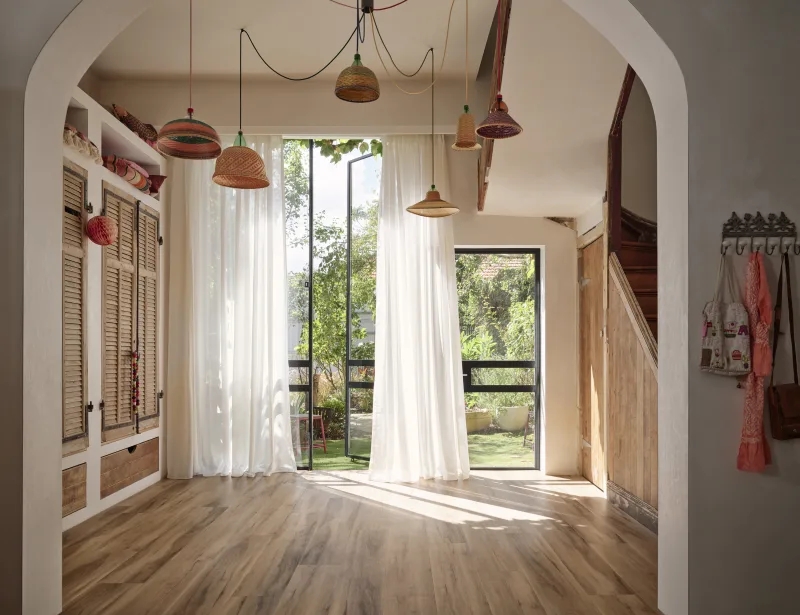
Five Renovation Trends Influencing Australian Homes and Lifestyles
Over the last 50 years, much has changed in building and interior design; most notably when it comes to style and how we choose to incorporate it into our homes.
From the classic brick and mahogany hues of 1970s homes to the minimalist movement in early 2000s and most recently the “greenification” of properties over recent years, our homes have experienced an extraordinary evolution.
Carpet Court, an Australian-owned and operated company, has long been at the forefront of trend movements, modifying and expanding their offerings so Australians can achieve their ideal home.
As they commemorate their 50th anniversary in 2023, their influence continues to shape our homes and lifestyles.
As part of their 50th anniversary celebrations, we had the pleasure of speaking with longtime ambassador and interior designer Darren Palmer to gain his insights on some of the most influential housing trends from over five decades ago.
He discussed how much has changed since 1973 when shag carpet reigned supreme at Carpet Court’s showrooms to the current trends which have had such an effect on our homes and lifestyles.
1. Minimalism and Maximalism
This trend of oscillating between minimalism and maximalism has come and gone over time, often favouring bold colors and materials one decade over the next, only for it to then switch back towards all-white everything a decade later.
The 80s were known for their decadence while the 90s saw more restrained spending habits.
Right now, though, brutalism and flamboyance interiors appear to be converging; Palmer mentions both styles being popular despite sometimes appearing at odds with one another.
On one end of the spectrum, modern renovators may choose soft yet muted floorboards – like Hickory Elegance hardwood timber floor – for minimalist looks.
On the other hand, they might prefer making an impactful statement by choosing Grand Oak Herringbone timber floors in Black Opal as they will add depth and character.
“Some people prefer creating an intimate home environment, while others want a completely streamlined appearance; this explains why minimalism and brutalism have become popular; both can provide this atmosphere.”
2. Global Influences
Although geographically isolated, Australia has drawn inspiration and trends from elsewhere around the globe for many of its aesthetic trends and aesthetics.
In the 1980s, Memphis style design from Italy quickly spread across Australia – its bold geometric shapes, bright colours and striking patterns were welcomed as something new in homes across Australia.
Early 2000s saw widespread influence from Bali and Thailand, from Thai temple doors to Buddha statues adorning our interiors.
From 2010-now, people have once again begun looking beyond our borders for greater perspectives, according to Palmer. He suggests this could be one of the reasons why style today has become less uniform than decades prior.
“Social media boomed for us; Pinterest and Instagram provided us with access to information from around the world as well as designers’ perspectives,” Palmer notes.
“That was when we witnessed an increase in design styles and an acceleration in development activities.
3. Timeless Design
With trends always shifting and changing, one constant has always remained: classic and timeless design.
Neutral tones, classic shapes, subtle textures and well-crafted furniture have always been in fashion and have proven timeless classics.
Palmer utilizes Carpet Court pieces when designing his projects.
Window treatments should have lasting quality, and Palmer prefers durable styles like sheer curtains, roller blinds and plantation shutters as window dressing options.
Palmer believes the decision to choose classic designs is highly dependent on economic considerations; renovators typically feel more at ease undertaking eccentric projects when their finances permit it.
Given current economic circumstances, timeless design, decor, furnishings and colors may be especially sought-after for renovation projects on a tight budget – particularly investment property renovation.
“People should aim to design something with wide market appeal that’s classic in style and will stand the test of time,” according to him.
Carpet Court’s ranges are some of my favorites and one reason I enjoy working with them, because their timeless classic aesthetic allows me to style them any way I see fit.”
“And with fifty years under their belts, it is no surprise they have found ways to meet customer demand.”
4. Eco-Friendliness
Sustainability and energy efficiency may now be of primary concern, but this wasn’t always the case.
Homes constructed during the 70s, 80s and 90s lacked insulation in general.
Ten years ago, environmental awareness was simply a buzzword,” Palmer says.
Now, in response to global challenges like climate change, Aussie homes are beginning to adapt by installing features such as solar panels and rainwater tanks – while recycled materials like brick, tiles and timber have become more widely utilized.
Palmer believes this trend will become even more prominent over time.
“If you don’t consider materials and their sources, solar heating and cooling, and all the other issues we now take for granted when making decisions, you are missing an enormous opportunity in the market,” according to Mr. Perrotti.
“People expect this.”
5. Individual Expression
In the 1970s and 80s, housing design was more uniform. Palmer notes this trend changed with self-expression becoming increasingly fashionable.
Aussies have long taken pride in personalising their renovations and builds, but this trend seems especially prominent today.
Palmer points out that one of the biggest trends emerging now is personalisation, due to our abundance of sources for inspiration.
“People today are much better educated as they have more reference points from which they can create their own individual aesthetic,” according to his words.
Palmer appreciates Carpet Court for this very reason: They strive to inspire their customers while also providing information and education that helps them feel more at home in their homes.
“Carpet Court strives to inspire Australians to create their dream homes, and this educational offering makes this possible.”
Regarding how to bring yourself into renovation projects, Palmer states rugs provide an effective means of self-expression.
“Rattan rugs make an artistic statement like art does,” states Mr. Zappitelli.
Rugs offer even greater opportunities to make a statement – they’re more graphic, colorful and have more pattern – making a larger impactful statement about you.”
Palmer advises that it is always best to express oneself when undertaking any renovation or building project.
At the core, renovators should focus on creating an environment that brings them joy, given how design can affect lifestyle, health and mood.
“Having an environment which reflects your identity and personality is ideal,” according to Hector.
“Expressing yourself can only make you feel better, seeing yourself reflected back at you makes the experience that much sweeter, and having your own space to do just that can only do good things.”
If you’re embarking on a renovation and adding your own distinctive touch to it, long-established market leaders like Carpet Court offer invaluable experience and can bring your home design ideas to fruition.

















